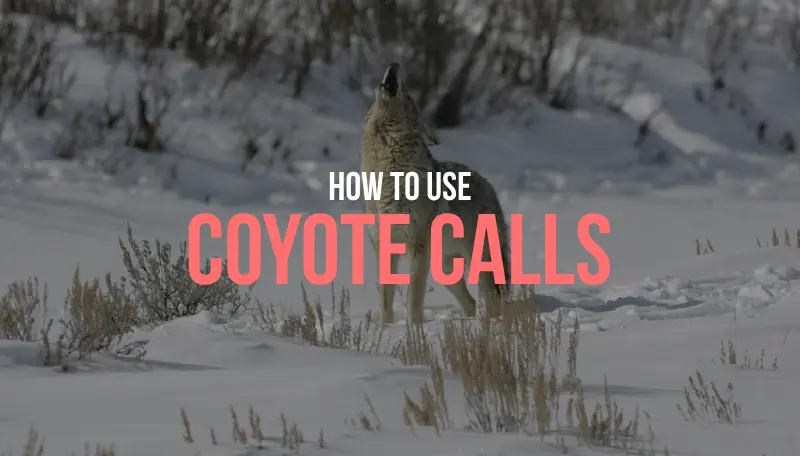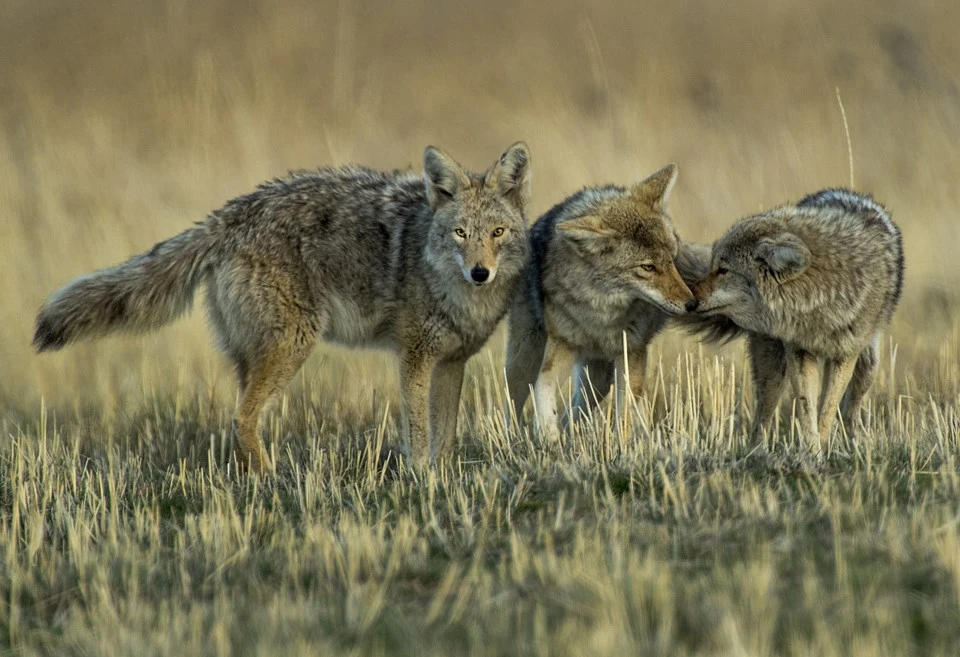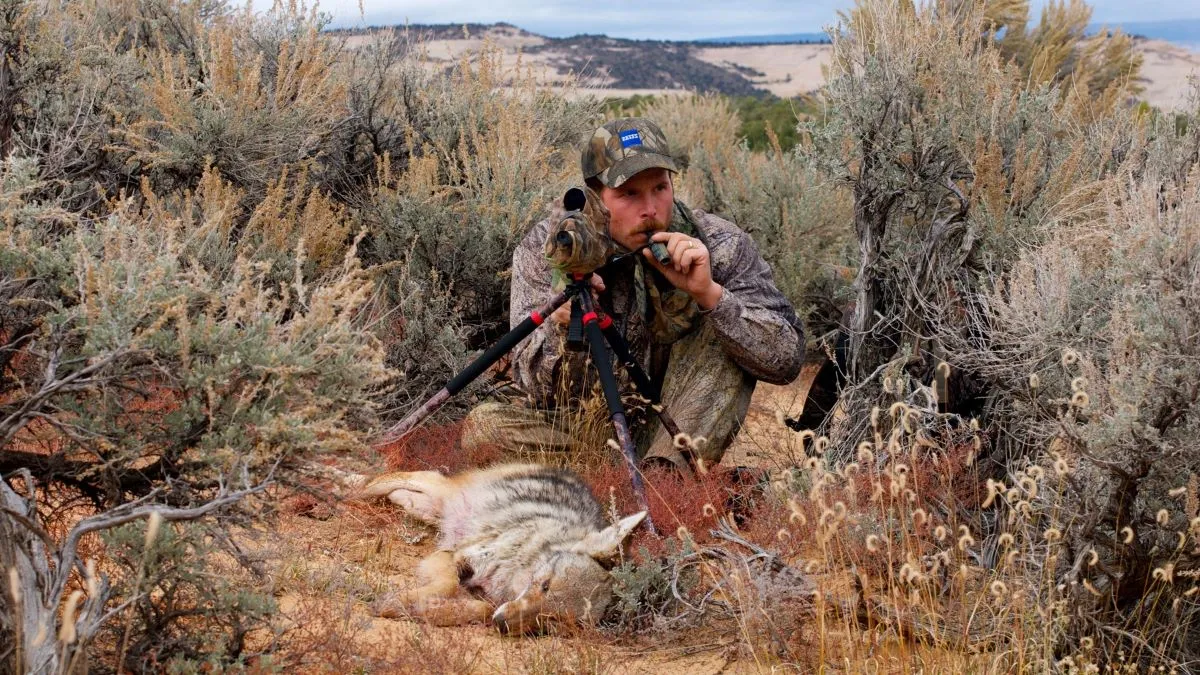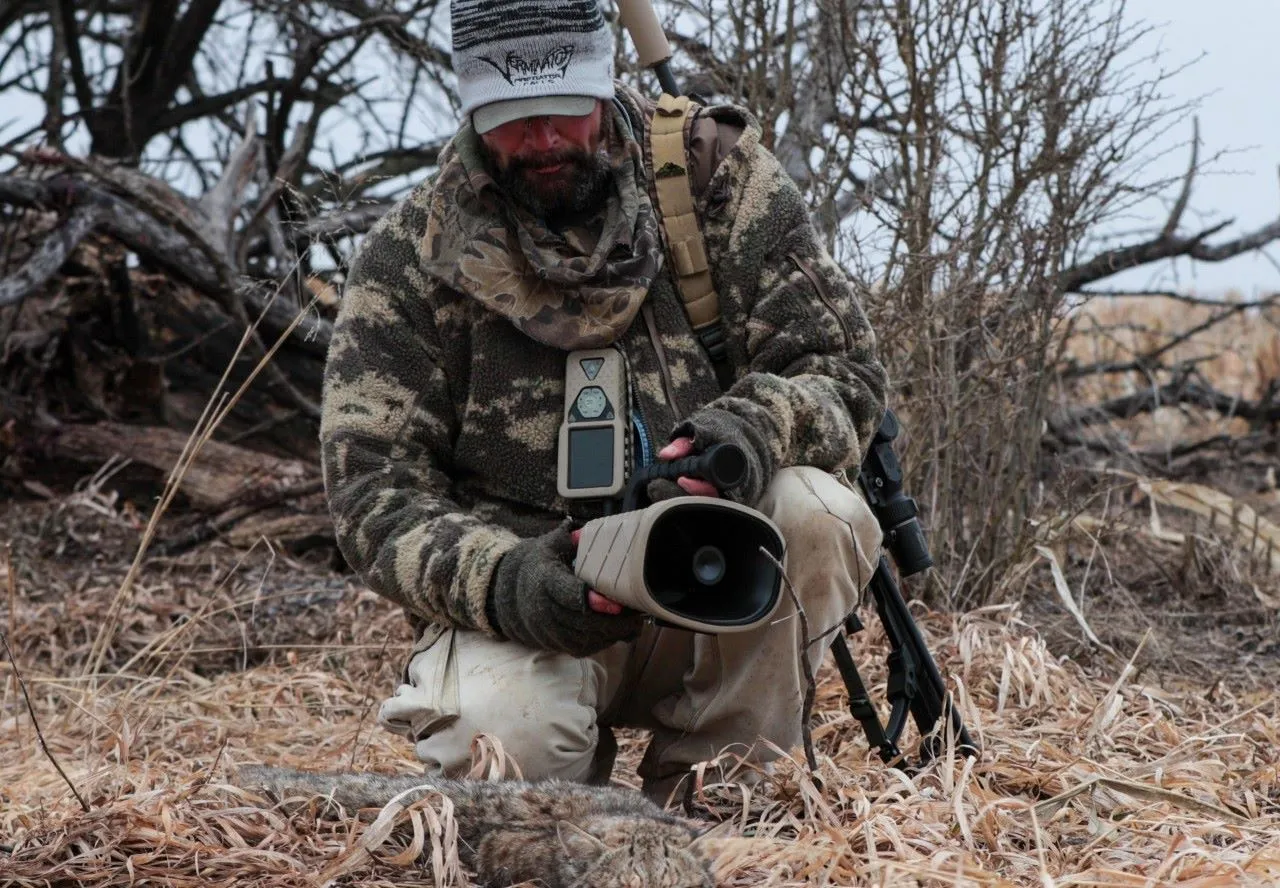
Coyote hunting is an adventure that’s as thrilling as it is challenging. It’s not just about the perfect hunting camo, accuracy, and patience – though those are crucial. It’s also about learning their language and knowing how to sing their song. This post will teach you how to create efficient coyote calling strategies as well as share some of the best coyote calls.
Table of Contents
A Quick Guide to Coyote Sounds
Coyote Behavior

Understanding coyote behavior throughout the year can significantly enhance your hunting skills. Coyotes typically breed in February, followed by a 60-day gestation period. For simplicity, let’s assume most pups are born in mid-April and stay in the den for about a month. Some hunters believe that winter is the best time to use non-aggressive male coyote howls and female yodels, as coyotes tend to be more vocal during the breeding period.
Come July, the pups begin to learn how to hunt, and their parents become fiercely protective. Practically any pup distress call can draw attention at this stage.
Things change in September and October when the breeding pairs expel the pups from their family territory because they don’t want their young competing for available food. Adult coyotes are now more likely to respond to the sounds of trespassing adolescents rather than protect them, making pup sounds again a good choice for luring.
Generally speaking, tapping into a coyote’s territorial instinct is one of the best calling strategies. Using coyote communication sounds can trick the predator into thinking its territory is being invaded by a rival pack, prompting a response. Coyotes are also opportunists when it comes to food. So, using sounds that suggest there’s a free meal can also get their attention.
Coyotes Vocalizations and What They Mean

Coyotes have a rich, varied vocabulary that they use to communicate with each other. Let’s look at some of the most common coyote sounds:
- Growl: A clear threat, primarily used when something is within close range.
- Huff: Involves the expulsion of air through the nose and mouth and is often used as a high-intensity threat in close range, particularly during disputes over food.
- Woof: A low-intensity threat or alarm sound made when a coyote is startled and unsure of what’s happening.
- Bark: A long-distance threat or alert of low to medium intensity. Coyotes often bark at humans, dogs, and other large animals that they perceive as threats to their territory. This sound is a common way for coyotes to express their territorial claims.
- Bark-howl: A blend of a bark and a howl used as a high-intensity, long-distance threat or alarm. Indicates disturbance or agitation.
- Screaming: A distress signal that eerily resembles a woman’s scream. It’s typically a response to a larger predator’s presence.
- Puppy-in-distress: The distress sounds of a coyote pup can vary but generally involve high-pitched howls, yips, and whines.
- Whine: Expresses submission by a subordinate coyote to a dominant one.
- Yelp: A bit higher than a whine, it indicates high-intensity submission. It can also be a reaction to being startled.
- Lone Howl: A single coyote’s howl, often prefaced by a series of barks; can help distinguish individual coyotes. Interestingly, coyotes use their lips and tongues to form signature howls.
- Group Howl: A collective howl is used when two or more coyotes reunite after being apart. It could also be a response to distant coyotes’ howls, providing location information.
- Yip-Howl is a distinctive sound made by coyotes, characterized by short howls that typically fluctuate in pitch and are punctuated by sharp yips, yaps, and barks. The group yip-howls are usually performed by an “alpha” pair of coyotes, essentially a mated and territorial couple. Typically, the male engages in howling while the female intersperses her sounds with yips, barks, and short howls. “Beta” coyotes, which are the offspring of the alpha pair from previous years, as well as current-year pups, may join the chorus if they are in proximity, or they may respond with their own howls.
The coyote’s language is indeed rich, but honestly, you only need to become proficient in three sounds to effectively find, lure, and harvest coyotes:
- Use the howl to locate and call in coyotes (in spring), determine the presence of coyotes in unfamiliar areas (year-round), and provoke a territorial response (during the mating season.)
- Use the puppy-in-distress call to provoke a protective response (during the denning season), to play on coyotes’ curiosity (year-round), to make them come for food (during winter.)
- Use the single bark or woof to stop a running coyote for an accurate shot (do not make a sequence of barks.)
Coyote Prey Sounds and How to Use Them
Coyote prey sounds are another effective hunting tool in addition to coyote sounds. Here are two reasons to use them:
Easy Meal Attraction: Coyotes are opportunistic hunters, always on the lookout for an easy meal. As such, the most effective call for coyote hunting is any sound that imitates distressed or wounded prey. These sounds signal to the coyote the possibility of an easy meal, as a wounded animal is less likely to be able to run or fight off the predator. Common coyote prey sounds include distress calls of fawns, rabbits, mice, squirrels, turkeys, ground dogs, prairie dogs, and other small animals and birds.
Adding Realism: Coyotes are smart animals, and pressured coyotes can learn to recognize commonly used sounds by hunters. To prevent this, adding realism by using unique sounds, such as bird sounds (crow, magpie), as well as mixing coyote sounds with prey distress sounds is crucial. This helps create a more believable scenario for the coyote, making it more likely to approach.
E-Caller vs. Hand-Held and Mouth Calls for Coyote Hunting
The debate between using a traditional predator call or an electronic predator caller has been ongoing amongst hunters. While some swear by the authenticity of hand-held calls, others are drawn to the versatility of e-callers. But is one truly better than the other? Let’s delve deeper into this question by exploring the pros and cons of each.
Traditional Calls for Predator Hunting

Hand-held and diaphragm calls offer a unique hunting experience that many traditionalists appreciate.
🟢 Unique distress sounds: Hand-held and diaphragm calls allow you to create sounds coyotes never heard. This can be particularly useful in areas where coyotes have become used to certain sounds. With a hand-held call, you can add your own nuances and variations to the calls, making them more likely to lure in wary coyotes.
🟢 Adaptability: Traditional calls give you the freedom to quickly change up the sound according to the situation. This can be useful when you’re trying to mimic the natural sound fluctuations of distressed prey.
🔴 Drawing Attention to Yourself: The main downside of traditional hand-held and mouth calls is that they draw attention to yourself. Since you’re the one making the noise, a savvy coyote might trace the sound back to its source and spot you before you spot it.
E-Calls for Predator Hunting

Electronic calls, on the other hand, bring technology into the mix, offering a wide array of sounds at the press of a button.
🟢 Variety of predator-hunting sounds: From the distress calls of various small mammals to the vocalizations of other coyotes, an e-caller can mimic a wide range of sounds.
🟢 Directing the coyote’s path with an e-caller placement: E-callers can be placed away from the hunter, which can help direct the path of incoming coyotes. By placing the e-caller in a strategic location, you can guide the coyote into a clear shooting lane.
🔴 Batteries and malfunctions: E-callers rely on batteries, which can run out at the most inconvenient times. They can also malfunction, especially in harsh weather conditions.
🔴 Educating and overcalling: There’s a risk of educating coyotes if the same sounds are used over and over or a risk of overcalling if calls are played too loudly and too frequently. This can make coyotes more cautious and call-shy.
Best Coyote Predator Calls – Review
Here are the best hand-held and mouth coyote calls:
PRIMOS Randy Anderson Howler Pak
This call pack offers a range of sounds, from full-blown howls to soft, subtle barks. Obviously, what sets this pack apart is its versatility. It comes with two distinct mouth calls, each designed to produce a different pitch. The Sonic Dome predator mouth call, with its higher pitch, is designed to mimic interrogation howls to attract more experienced coyotes. On the other hand, the Double Howler predator mouth call produces a deeper pitch, perfect for replicating the lonesome greeting howl of a coyote. Both calls are capable of producing the full spectrum of coyote howls and distress calls, giving you the versatility to adapt to any hunting scenario.
The pack also includes a megaphone to amplify your calls and give them direction, increasing your calling range and enhancing your control over the sound, as well as a mini-DVD with calling tips.
PRIMOS Hot Dog Predator Call
Next up is the PRIMOS Hot Dog predator call. This call is a fantastic all-rounder, capable of producing a wide variety of distress calls of birds, cottontails, jackrabbits, pups, and fawns as well as coyote yelps, barks, and howls. It’s loud, making it the perfect locator call for those open-field scenarios where you need to reach out to distant coyotes. Remember, the deeper you’re on the reed, the lower the pitch.
PRIMOS Ki-Yi Predator Call
The name “Ki-Yi” comes from the sound an injured dog makes, and this call nails a coyote pup’s whines perfectly. The call features a removable mouthpiece for open reed calling allowing you to change the tone of the sound and mimic a host of prey animals, like rabbit screams or fawn distress calls.
PRIMOS Double Jackrabbit Predator Call
The PRIMOS Double Jackrabbit Predator Call is designed to mimic the distress calls of a jackrabbit, a favorite meal of coyotes. This call’s dual reeds create a unique, raspy sound that carries well over long distances. It’s also incredibly easy to use, making it a great choice for beginners. However, it’s not just for newbies – many seasoned hunters swear by this call for its reliability and effectiveness. Plus, this call works on other predators, like bobcats and foxes, making it a must-have for every passionate predator hunter.
PRIMOS Still Mouse Squeaker Predator Call
For those close encounters, turn to the PRIMOS Still Mouse Squeaker. Designed to mimic the soft, high-pitched squeaks of a mouse and other field rodents, this call is perfect for drawing in coyotes that are already nearby. Its compact size makes it easy to carry and use without giving away your position.
HAYDELS Small Game Deluxe 3-in-1 Squirrel Call
Though not specifically a coyote call, this HAYDELS Squirrel Call deserves a mention for its versatility. It can produce three distinct squirrel sounds: the bark, the chatter, and the squeal. These sounds can pique the curiosity of any nearby coyote. It’s a great addition to any predator hunter’s gear, providing an alternative sound that can mix things up and keep coyotes guessing.
FAQs
What is the best call sound for coyotes?
The distressed rabbit call is often considered the most effective sound for luring in coyotes. This is because it taps into their predatory instincts and desire for an easy meal.
What time of day is best for calling coyotes?
Coyotes are most active during dawn and dusk, so these are typically the best times to use your calls. However, they can be active at any time of day or night, so don’t limit yourself strictly to these times.
How far can a coyote hear a call?
A coyote’s hearing is incredibly sharp. Depending on the terrain and weather conditions, a coyote can hear a call from up to one mile away!
How do you call coyotes for beginners?
Start by learning a few basic sounds like the distressed rabbit call, the howl, the bark, and the pup whine. Practice them until you’re comfortable, then try using them in the field.
Can you call coyotes too much?
Yes, over-calling can make coyotes wary and may even scare them off. It’s important to strike a balance. Start with a series of calls, wait for 15-20 minutes, then try again if there’s no response. Be patient, and remember that less is often more when it comes to coyote calling.












Leave a Reply